High Impact Tutoring Built By Math Experts
Personalized standards-aligned one-on-one math tutoring for schools and districts
In order to access this I need to be confident with:

Area of composite shapes
Here you will learn about the area of composite shapes, including questions involving rectilinear shapes, composite shapes, missing side lengths and unit conversion.
Students will first learn about composite shapes as part of geometry in 3rd grade when they learn how to decompose and find the area of rectilinear shapes.
Students deepen their understanding of area in 4th grade, and extend their learning by finding the area of more complex shapes in 6th grade.
What is the area of composite shapes?
The area of composite shapes is the amount of space inside a shape composed of basic shapes put together. It is measured in square units ( cm^2, m^2, mm^2 etc.).
Composite shapes can also be called compound shapes or composite figures.
To find the area of composite shapes, you must decompose the composite shape into basic shapes, then find the area of each of the basic shapes and add them together.
For example,
\begin{aligned} \hspace{0.5cm} \text{\color{#f22e76}Area of Shape A} \, + \, \text{\color{#1682e0}Area of Shape B} \, &= \, \text{Area of Compound Shape} \hspace{0.5cm} \\\\ {\color{#f22e76}(7m \times 2m)} \quad + \quad {\color{#1682e0}(3m \times 3m)} \quad \quad \, & = \\\\ {\color{#f22e76}14m^2} \quad \quad + \quad \quad {\color{#1682e0}9m^2} \quad \quad \quad \;\;\; &= \quad \quad \quad 23m^2 \end{aligned} |
Your final answer must be in square units. For example, square centimeters (cm^2), square meters (m^2), square feet (ft^2), etc.
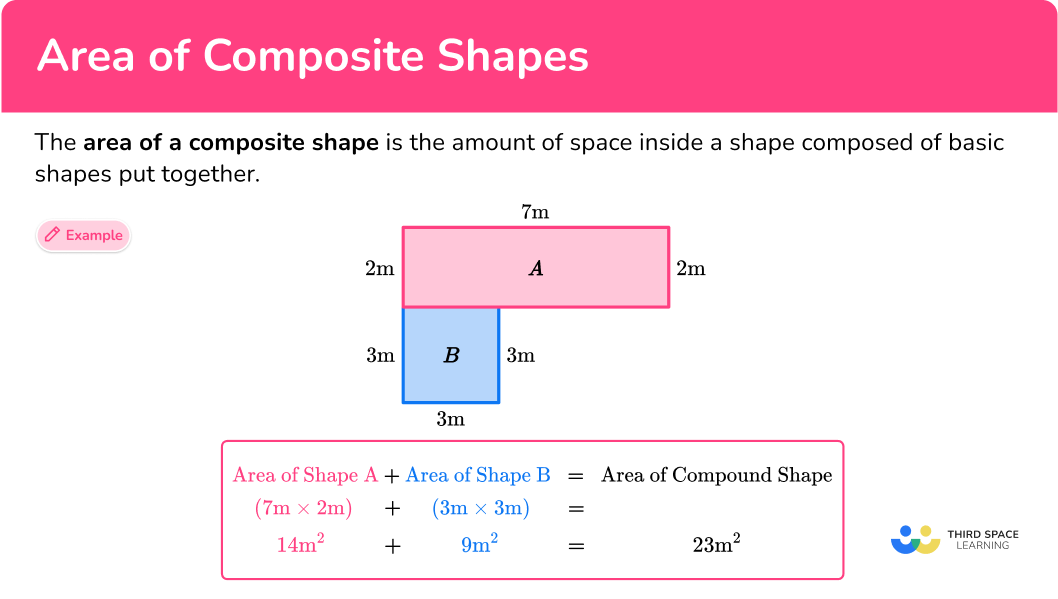
[FREE] Area of Composite Shapes Worksheet (Grade 3 to 8)
Use this worksheet to check your grade 3 to 8 students’ understanding of calculating the area of composite shapes. 15 questions with answers to identify areas of strength and support!
Common Core State Standards
How does this relate to 3rd grade math and 4th grade math?
- Grade 3 – Measurement and Data (3.MD.7, 3.MD.7.d) Relate area to the operations of multiplication and addition; Recognize area as additive. Find areas of rectilinear figures by decomposing them into non-overlapping rectangles and adding the areas of the non-overlapping parts, applying this technique to solve real world problems.
- Grade 4 – Measurement and Data (4.MD.3) Apply the area and perimeter formulas for rectangles in real world and mathematical problems. For example, find the width of a rectangular room given the area of the flooring and the length, by viewing the area formula as a multiplication equation with an unknown factor.
- Grade 6 – Geometry (6.G.1) Find the area of right triangles, other triangles, special quadrilaterals, and polygons by composing into rectangles or decomposing into triangles and other shapes; apply these techniques in the context of solving real-world and mathematical problems.
How to find the area of composite shapes
Here’s how to find the area of composite shapes:
- Break down the composite shape into simpler shapes, such as rectangles, triangles, etc.
Find the measurements and areas of the simpler shapes.
Add the areas of the simpler shapes together.
Write down your final answer with square units.
Area of composite shapes examples
Example 1: all side lengths given (area of a rectilinear figure).
Find the area of the composite shape below:
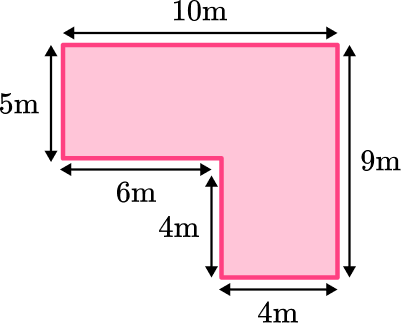
- Break down the composite shape into basic shapes.
Split the composite shape into two rectangles. You can do this in two ways:
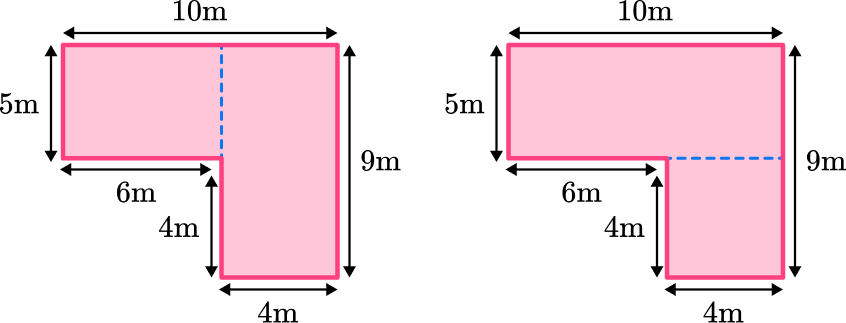
For the purposes of this question you will use the first way.
2 Find the measurements and area of the simpler shapes.
Label the two rectangles A and B.
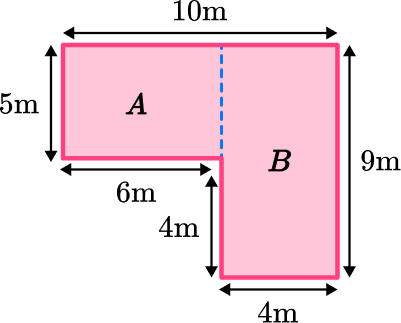
Area of Rectangle A :
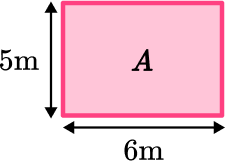
\begin{aligned} \text { Area }_{A} &=\text{ length } \times \text{ width } \\\\ \text { Area }_{A} &=6 \times 5 \\\\ &=30 \end{aligned}
Area of Rectangle B :
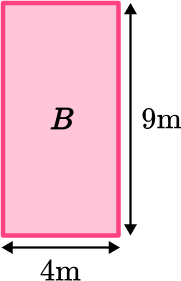
\begin{aligned} \text { Area }_{B} &=\text{ length } \times \text{ width } \\\\ \text { Area }_{B} &=9 \times 4 \\\\ &=36 \end{aligned}
3 Add the areas of the simpler shapes together.
\begin{aligned} \text { Composite Area } &=\text{ Area of } A+ \text{ Area of } B \\\\ &= 30+36 \\\\ &=66 \end{aligned}
4 Write down your final answer with square units.
\text{ Area }=66 \mathrm{~m}^{2}
Example 2: missing lengths
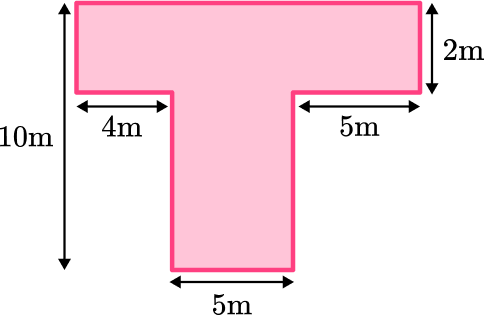
Break down the composite shape into simpler shapes.
Split the composite shape into two rectangles and find the area of each rectangle.
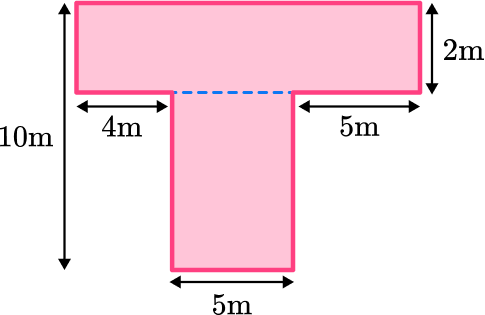
You need to calculate the unknown length. To do this, you need to use the measurements you are given in the question that are parallel to the unknown side:
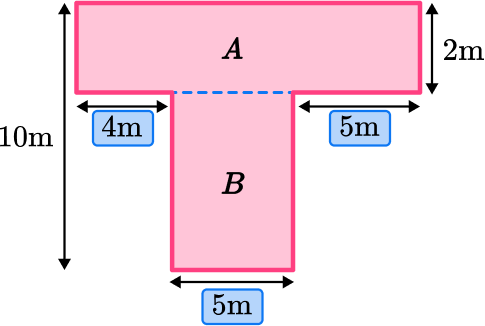
If you add together the 3 sides, you will get the length of rectangle A.
4+5+5= 14 \, m

\begin{aligned} \text { Area }_{A} &=\text{ length } \times \text {width } \\\\ \text { Area }_{A} &=14 \times 2 \\\\ &=28 \end{aligned}
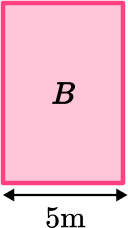
The length of the entire composite shape is 10 \, m. You need to subtract the 2 \, m of shape A to get just the length of shape B.
\begin{aligned} \text { Area }_{B} &=\text{ length } \times \text{ width } \\\\ \text { Area }_{B} &=8 \times 5 \\\\ &=40 \end{aligned}
\begin{aligned} \text { Composite Area } &=\text{ Area of } A+\text{ Area of } B \\\\ &=28+40 \\\\ &=68 \end{aligned}
\text{ Area }=68 \mathrm{~m}^{2}
Example 3: word problem
The wall shown below needs to be painted. Each tin of paint covers a distance of 4 square meters. How many tins of paint will be needed to cover the entire wall?
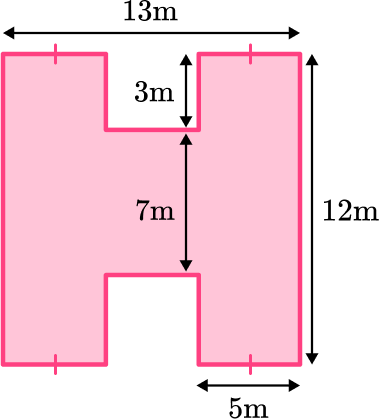
Split the composite shape into three rectangles and find the area of each rectangle.
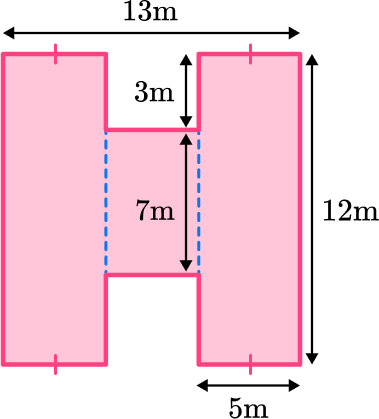
Label the three rectangles A, B and C.
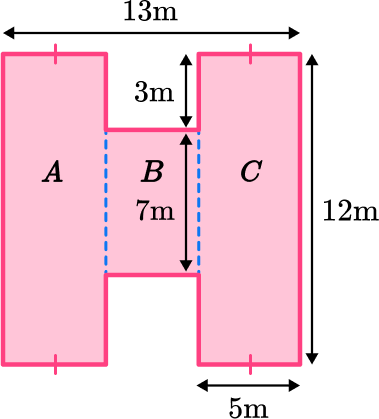
Notice that rectangle A and C each have a tick mark at the bottom. This means that these sides are congruent, or equal. Therefore, we know the width of rectangle A is 5 \, m.
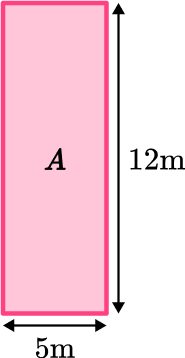
\begin{aligned} \text { Area }_{A} &=\text{ length } \times \text{ width } \\\\ \text { Area }_{A} &=12 \times 5 \\\\ &=60 \end{aligned}
Rectangle C is congruent to Rectangle A, so you can just double the area of rectangle A.
60 \times 2=120
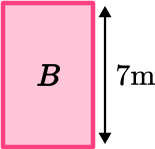
You need to calculate the unknown width. To do this, you need to use the measurements you are given in the question that are parallel to the unknown side:
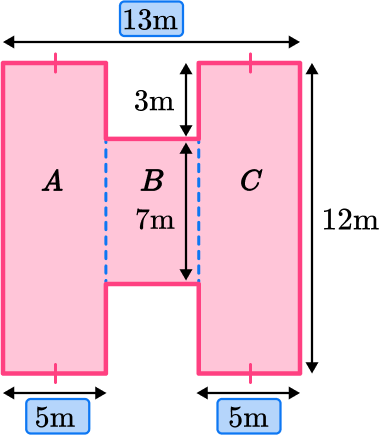
The entire width of the shape is 13 \, m. If you subtract 5 \, m and 5 \, m \; ( the width of rectangles A and C).
13 - 5 - 5 = 3 \, m
\begin{aligned} \text{ Area }_{B} &=\text { length } \times \text{ width } \\\\ \text{ Area }_{B} &=7 \times 3 \\\\ &=21 \end{aligned}
\begin{aligned} \text { Composite Area } &=\text{ Area of } A+\text{ Area of } B+\text{ Area of } C \\\\ &=60+21+60 \\\\ &=141 \end{aligned}
\text { Area }=141 \mathrm{~m}^{2}
While this is the total area, you need to calculate how many tins of paint will be needed to cover the wall.
If each tin of paint covers a distance of 4 square meters, you need to divide 4 into 141.
141 \div 4=35.25
Since you cannot buy 0.25 of a can of paint, you need to round your answer to 36 tins of paint.
Answer \textbf{= } \bf{36} tins of paint will be needed .
Example 4: composite shapes involving non-rectangular shapes
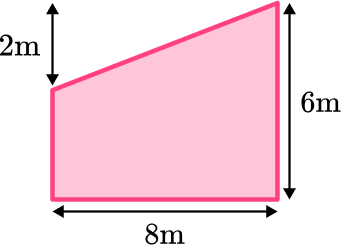
Split the composite shape into a triangle and rectangle.
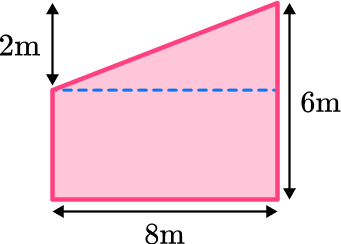
Note: This shape is a trapezoid. Another way to find the area of this shape would be to simply use the formula for the area of a trapezoid. For this question, because you are focusing on composite shapes, you will separate the shape into a triangle and a rectangle.
See also: Area of a trapezoid
Label the two shapes A and B.
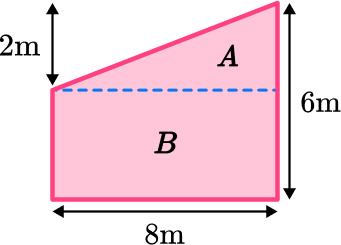
Area of Triangle A :
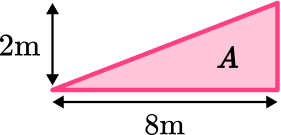
\begin{aligned} \text { Area }_{A} &=\cfrac{b \, \times h}{2} \\\\ \text { Area }_{A} &=\cfrac{2 \, \times 8}{2} \\\\ &=8 \end{aligned}
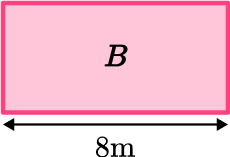
The height of the entire composite shape is 6 \, m. You need to subtract the 2 \, m of shape A to get just the length of shape B.
\begin{aligned} \text { Area }_{B} &=\text{ length } \times \text{ width } \\\\ \text { Area }_{B} &=8 \times 4 \\\\ &=32 \end{aligned}
\begin{aligned} \text{ Composite Area } &=\text{ Area of } A+\text{ Area of } B \\\\ &=8+32 \\\\ &=40 \end{aligned}
\text{ Area }=40 \mathrm{~m}^{2}
Example 5: missing side lengths
Calculate the value of x in the composite shape below:
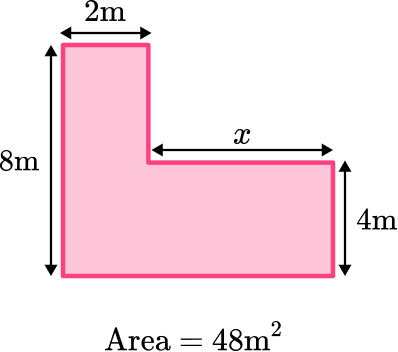
Split the composite shape into two rectangles.
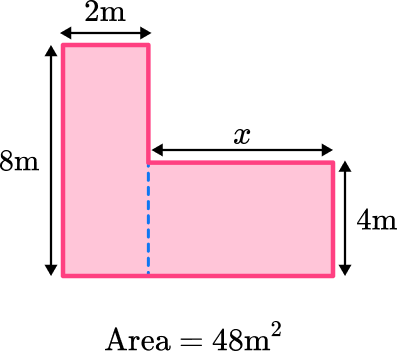
Find the measurements and area of the simpler shapes.
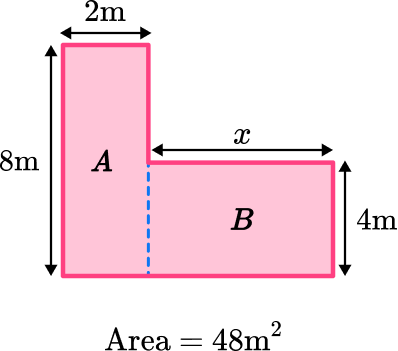
\begin{aligned} \text { Area }_{A} &=\text{ length } \times \text{ width } \\\\ \text { Area }_{A} &=8 \times 2 \\\\ &=16 \end{aligned}
In this case, you are not given enough information to find the area of Rectangle B.
Add the areas of the simpler shapes.
For this problem, you will need to use subtraction in order to find the area of rectangle B.
\begin{aligned} \text{ Composite Area } &=\text{ Area of } A+\text{ Area of } B \\\\ 48 &=16+\text{ Area of } B \\\\ \text{ Area of } B &=48-16 \\\\ \text{ Area of } B &=32 \end{aligned}
Now that you know the area of rectangle B, you can calculate the value of x.
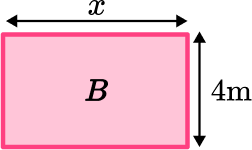
\begin{aligned} \text{ Area of } B &=l \times w \\\\ 32 &=l \times 4 \\\\ l &=\cfrac{32}{4} \\\\ l &=8 \, m \end{aligned}
Example 6: multi-step word problem
Below is a blueprint for a garden to be created in the middle of town. It will feature a triangular flowerbed and the remainder of the garden will be covered in grass.
Each roll of grass costs \$24 and covers a distance of 3 square meters. How much will it cost to cover the garden with grass?
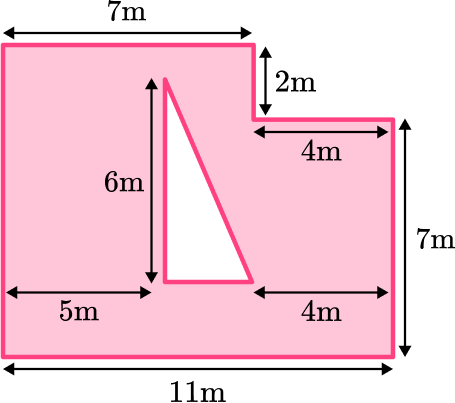
Split the composite shape into two rectangles. Once you find the area of the two rectangles, you can subtract the area of the triangle.
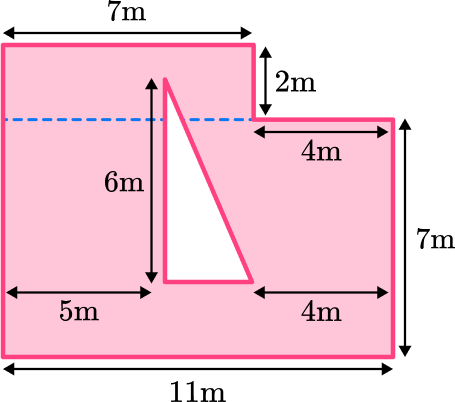
Label the three shapes A, B and C.
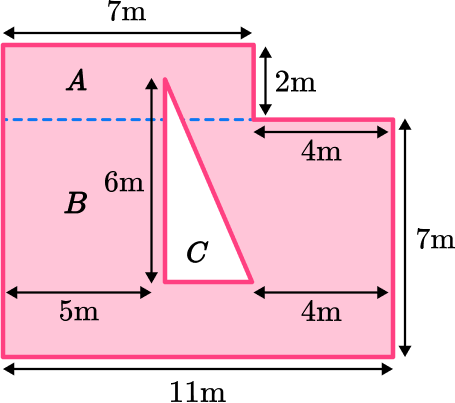
Area of rectangle A :
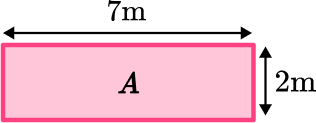
\begin{aligned} \text { Area }_A & =\text{ length } \times \text{ width } \\\\ \text { Area }_A & =7 \times 2 \\\\ & =14 \mathrm{~m}^2 \end{aligned}
Area of rectangle B :
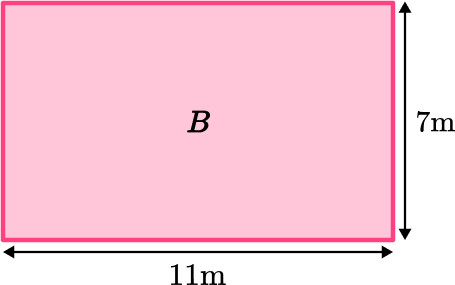
\begin{aligned} \text{ Area }_{B} &=\text{ length } \times \text{ width } \\\\ \text { Area }_{B} &=11 \times 7 \\\\ &=77 \mathrm{~m}^{2} \end{aligned}
Area of Triangle C :
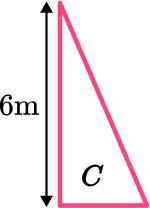
The height of the triangle is 6 \, m.
You need to calculate the unknown width of the triangle. To do this, you need to use the measurements you are given in the question that are parallel to the unknown side:
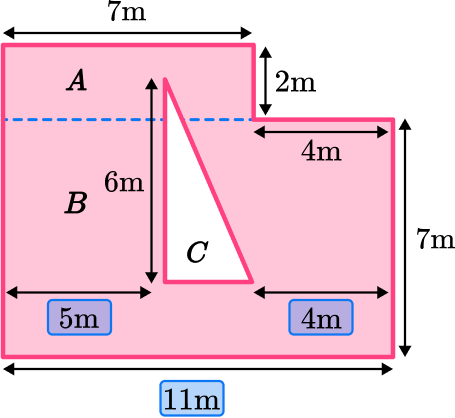
The width of the entire composite shape is 11 \, m. You need to subtract the 5 \, m and 4 \, m from 11 \, m to get the width of shape C.
\begin{aligned} \text{ Area }_{C} &=\cfrac{1}{2} \, (\text{ base } \times \text{ height }) \\\\ \text{ Area }_{C} &=\cfrac{2 \, \times \, 6}{2} \\\\ &=6 \, m^{2} \end{aligned}
\begin{aligned} \text{ Composite Area } &=\text{ Area of } A+\text{ Area of } B-\text{ Area of } C \\\\ &=14+77-6 \\\\ &=85 \end{aligned}
\text { Area }=85 \mathrm{~m}^{2}
Teaching tips for area of composite shapes
- Start with simple shapes like two rectangles before moving onto more complex shapes like triangles and trapezoids.
- Instead of worksheets, offer students a variety of ways to practice finding the area of composite shapes. One idea is for students to create composite shapes (either on paper, using manipulatives, or using an interactive website) and have a partner find the area.
Easy mistakes to make
- Using incorrect units for the answer A common mistake is to forget to include square units when asked to find area.
- Forgetting to convert measures to a common unit Before using the formula for calculating the area of a rectangle, you must look at the units given in the question. If different units are given, for example, length = 4 \, m and width = 3 \, cm, you must convert them either both to cm or both to m.
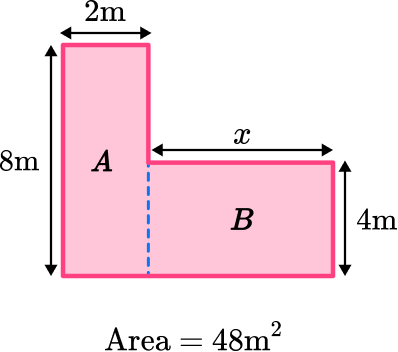
Related area lessons
- Area of isosceles triangle
- Area of a right triangle
- Area of equilateral triangle
- Area of obtuse triangle
- Area of a hexagon
- Area of a pentagon
- Area of irregular shapes
Practice area of composite shapes questions
1. Find the area of the composite shape below:
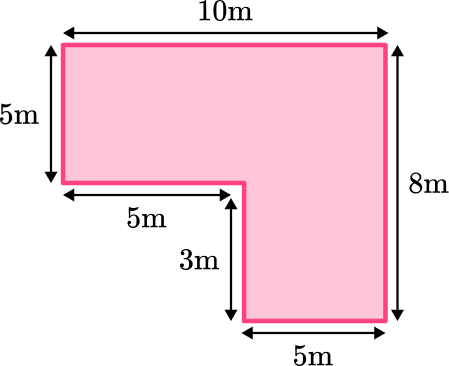
Split into two rectangles. Find the area of the rectangle and the area of the square and add them together.
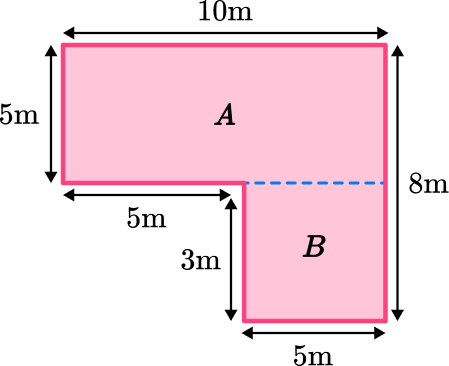
Area of A\text{: } 10 \times 5=50
Area of B\text{: } 5 \times 3=15
Composite Area: 50+15=65 \, m^2
2. Find the area of the composite shape below:
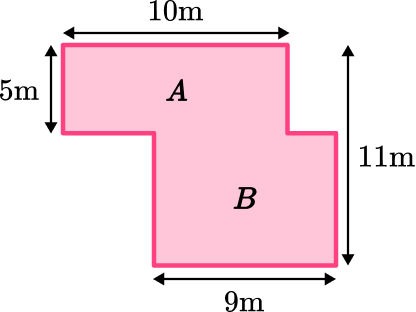
Split into two rectangles. Find the area of the smaller rectangle and the larger rectangle and add them together.
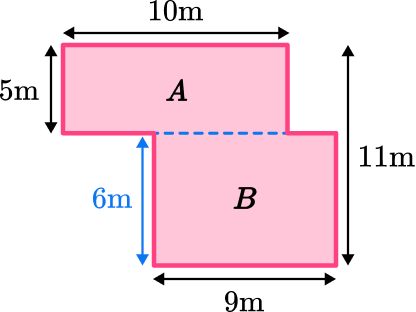
Area of B\text{: } 9 \times 6=54
Composite Area: 50+54=104 \, m^2
3. The wall shown below needs to be painted. Each tin of paint covers a distance of 4 square meters. How many tins of paint will be needed to cover the entire wall?
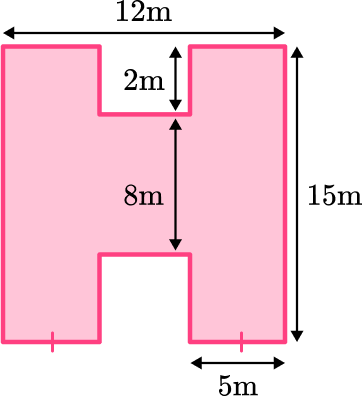
Split into three rectangles:
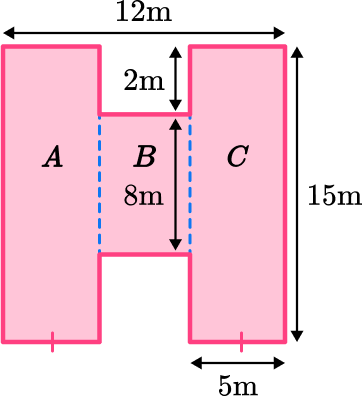
Area of A\text{: } 15 \times 5=75
Area of B\text{: } 8 \times 2=16
Area of C\text{: } 15 \times 5=75
Composite Area: 75+16+75=166 \, m^2
Then divide by 4 to get the number of tins.
166 \, m^2 \div 4=41.5
Since you can’t buy 0.5 of a tin, the answer will be rounded up to 42 tins.
4. Find the area of the composite shape below:
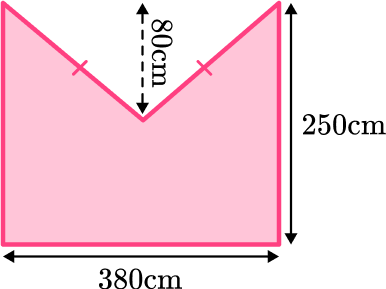
Split into one rectangle and two triangles:
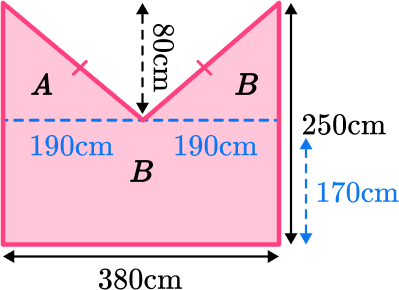
Since you know the triangles are congruent, you can use the base of the rectangle to find the base of the triangles.
380 \mathrm{~cm} \div 2=190 \mathrm{~cm}
Area of A\text{: } \cfrac{1}{2} \, (190 \times 80)=7,600
Area of B\text{: } \cfrac{1}{2} \, (190 \times 80)=7,600
Area of C\text{: } 170 \times 380=64,600
Composite Area: 7,600+7,600+64,6000=79,800 \mathrm{~m}^2
5. Find the value of x in the composite shape below:
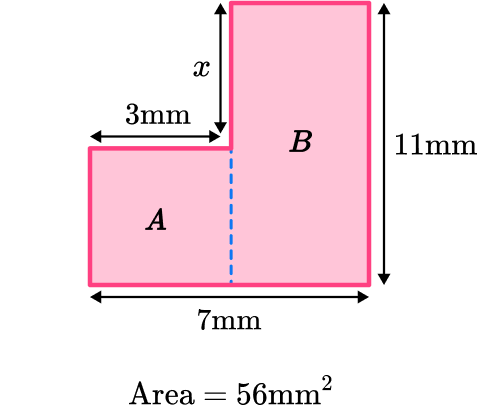
Split into two rectangles:
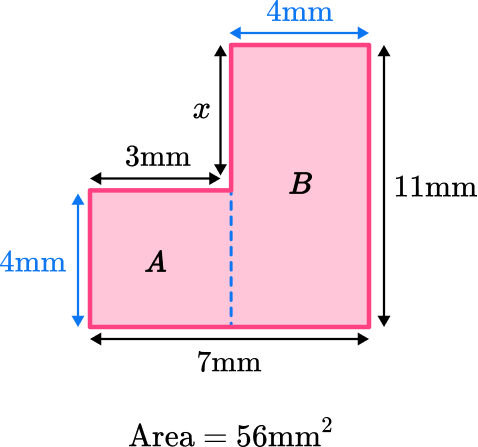
Area of B\text{: } 4 \mathrm{~mm} \times 11 \mathrm{~mm}=44 \mathrm{~mm}^2
The difference between the total area and the area of rectangle B will give you the area of rectangle A\text{:}
56 \mathrm{~mm}^2-44 \mathrm{~mm}^2=12 \mathrm{~mm}^2
The area of rectangle A divide by its width will give you the missing side length:
12 \mathrm{~mm}^2 \div 3 \mathrm{~mm}=4 \mathrm{~mm}
The difference between the length of rectangle B and the length of rectangle A gives you the value of missing side length x.
11 \mathrm{~mm}-4 \mathrm{~mm}=7 \mathrm{~mm}
6. An architect is developing a blueprint for one floor of a house which is shown below. The shaded region represents the floor and will need to be fully tiled. Each square tile has a width of 12 \, cm. How many tiles will be needed to cover the entire floor?
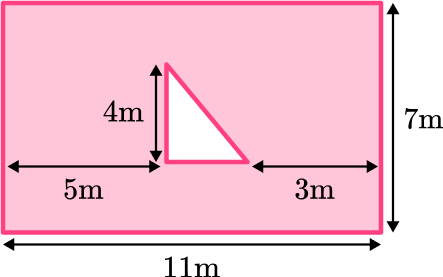
To find the area of the shaded region, you need to first find the total area of the rectangle. Then find the area of the triangle.
Instead of adding the areas together, here you will be subtracting the areas.
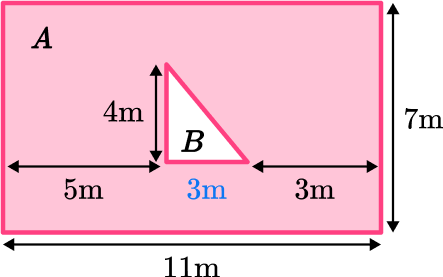
Area of A\text{: } 7 \times 11=77
Area of B\text{: } \cfrac{1}{2} \, (4 \times 3)=6
\begin{aligned} & 77-6=71 \mathrm{~m}^2 \\\\ & 12 \mathrm{~cm}=0.12 \mathrm{~m} \end{aligned}
Area of 1 tile =0.12 \times 0.12=0.0144 \mathrm{~m}^2
71 \div 0.0144=4,930.56 tiles
4,931 tiles
Area of composite shapes FAQs
A composite is a shape composed of basic shapes put together. A composite shape can also be called a compound shape or a composite figure.
The next lessons are
- Area of a quadrilateral
Still stuck?
At Third Space Learning, we specialize in helping teachers and school leaders to provide personalized math support for more of their students through high-quality, online one-on-one math tutoring delivered by subject experts.
Each week, our tutors support thousands of students who are at risk of not meeting their grade-level expectations, and help accelerate their progress and boost their confidence.

Find out how we can help your students achieve success with our math tutoring programs .
[FREE] Common Core Practice Tests (3rd to 8th Grade)
Prepare for math tests in your state with these 3rd Grade to 8th Grade practice assessments for Common Core and state equivalents.
Get your 6 multiple choice practice tests with detailed answers to support test prep, created by US math teachers for US math teachers!
Privacy Overview

Child Login
- Kindergarten
- Number charts
- Skip Counting
- Place Value
- Number Lines
- Subtraction
- Multiplication
- Word Problems
- Comparing Numbers
- Ordering Numbers
- Odd and Even
- Prime and Composite
- Roman Numerals
- Ordinal Numbers
- In and Out Boxes
- Number System Conversions
- More Number Sense Worksheets
- Size Comparison
- Measuring Length
- Metric Unit Conversion
- Customary Unit Conversion
- Temperature
- More Measurement Worksheets
- Writing Checks
- Profit and Loss
- Simple Interest
- Compound Interest
- Tally Marks
- Mean, Median, Mode, Range
- Mean Absolute Deviation
- Stem-and-leaf Plot
- Box-and-whisker Plot
- Permutation and Combination
- Probability
- Venn Diagram
- More Statistics Worksheets
- Shapes - 2D
- Shapes - 3D
- Lines, Rays and Line Segments
- Points, Lines and Planes
- Transformation
- Quadrilateral
- Ordered Pairs
- Midpoint Formula
- Distance Formula
- Parallel, Perpendicular and Intersecting Lines
- Scale Factor
- Surface Area
- Pythagorean Theorem
- More Geometry Worksheets
- Converting between Fractions and Decimals
- Significant Figures
- Convert between Fractions, Decimals, and Percents
- Proportions
- Direct and Inverse Variation
- Order of Operations
- Squaring Numbers
- Square Roots
- Scientific Notations
- Speed, Distance, and Time
- Absolute Value
- More Pre-Algebra Worksheets
- Translating Algebraic Phrases
- Evaluating Algebraic Expressions
- Simplifying Algebraic Expressions
- Algebraic Identities
- Quadratic Equations
- Systems of Equations
- Polynomials
- Inequalities
- Sequence and Series
- Complex Numbers
- More Algebra Worksheets
- Trigonometry
- Math Workbooks
- English Language Arts
- Summer Review Packets
- Social Studies
- Holidays and Events
- Worksheets >
- Geometry >
- Compound Shapes
Composite Shapes Worksheets | Area of Compound Shapes
This compilation of meticulously crafted printable area of compound shapes worksheets for students of 6th grade, 7th grade, and 8th grade extends two levels of composite figures to prep up finding the area. Simple plane shapes like triangles, rectangles, squares, parallelograms, rhombus, trapezoids, circles, semicircles, and quadrants compose the figures in our pdf area of composite shapes worksheets. The combinations include two or more overlapping and non-overlapping shapes with whole-number and decimal dimensions. Free worksheets are also included.
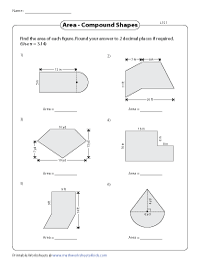
Adding Area - Two Regions | Whole Numbers
Introduce children to the area addition postulate, which states that the total area of a compound shape made of two non-overlapping shapes is the sum of the individual areas. Apply it and work out this exercise.
- Download the set
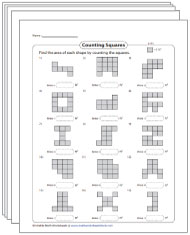
Area of Rectilinear Figures Worksheets
Explore this section of area of complex figures worksheets for grade 2 to grade 5 to secure fundamental practice on the area of a rectilinear figure - a basic composite shape composed of non-overlapping rectangles.
(25 Worksheets)
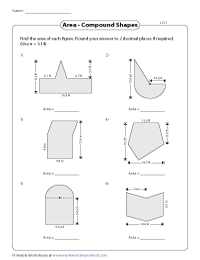
Adding Area - Two Regions | Decimals
These printable pdfs depict combinations of two shapes, such as squares and semicircles or triangles and rectangles for instance, with decimal dimensions. Sum up the individual areas for the total area.
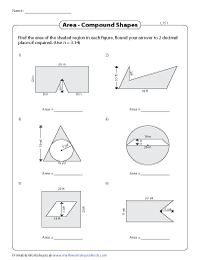
Subtracting Area - Two Regions | Whole Numbers
Surpass your peers by finding the area of composite figures made of simple shapes that overlap. Subtract the area of the unshaded figure from the total area to arrive at the area of the shaded region.
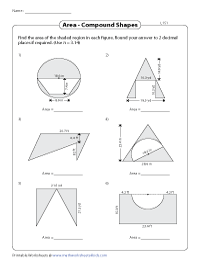
Subtracting Area - Two Regions | Decimals
Task grade 6 and grade 7 children with completing this pack of printable area of compound shapes worksheets so they ace determining determine the area between two shapes or the area of the shaded region using subtraction.

Adding Area - 3 or More Regions | Whole Numbers
The composite shapes here comprise three or more shapes. Decompose the complex figures into simple shapes, find their areas using the whole-number measures, and combine them to calculate the total area.
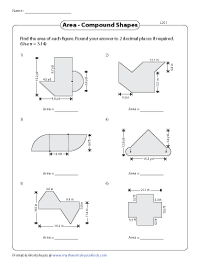
Adding Area - 3 or More Regions | Decimals
Implement the additive-area method to answer these area of composite shapes worksheets. Compute the area of 3 or more shapes that compose the complex figure using the relevant formulas, and add them.
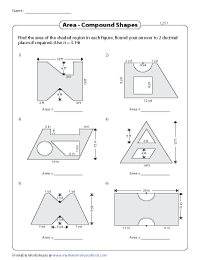
Subtracting Area - 3 or More Regions | Whole Numbers
Two or more shapes within another shape and regions sharing borders as the overlapping parts make these area of compound shapes worksheets a tough nut to crack. Solve for the area and streak ahead!
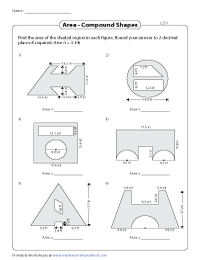
Subtracting Area - 3 or More Regions | Decimals
Accomplishing the tasks in these pdfs with decimal measures, grade 7 and grade 8 students scale the heights of finding the area of complex figures. They need to round the area to 2 decimal places if necessary.
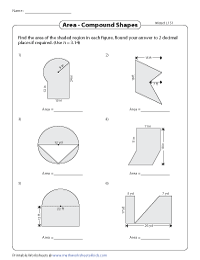
Area of Compound Shapes | Mixed Review - Level 1
Review finding the area of compound figures with these printable worksheets. Break down each compound shape into standard shapes; obtain their areas; add or subtract them to arrive at the total area.
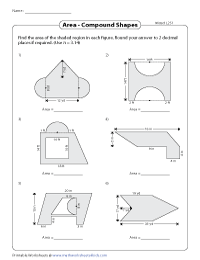
Area of Compound Shapes | Mixed Review - Level 2
An excellent resource to test the skills of 6th grade, 7th grade, and 8th grade students, these area of composite shapes worksheets have complex figures made of both overlapping and non-overlapping shapes.
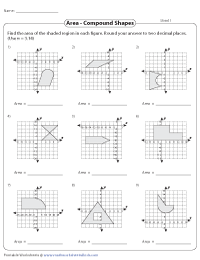
Area of Compound Shapes on Grids
In these pdf worksheets, students determine dimensions of the decomposed shapes using the units on the X and Y axes, and calculate the area of the shaded portion of the figures displayed on the grids.
Related Worksheets
» Area of Triangles
» Area of Mixed Shapes
» Area of Circles
» Area of Quadrilaterals
» Area of Polygons
Become a Member
Membership Information
Privacy Policy
What's New?
Printing Help
Testimonial
Copyright © 2024 - Math Worksheets 4 Kids
This is a members-only feature!

Composite Area Worksheets
Related Topics: More Math Worksheets More Printable Math Worksheets More Grade 7 Math Lessons
Printable “Area” worksheets: Area of Rectangles Word Problems Area of Rectangles Word Problems (interactive) Area of Composite Rectangles Composite Area Worksheets (include circles)
Examples, solutions, videos, and worksheets to help Grade 7 students review how to solve composite area problems.

How to solve composite area problems?
Composite area problems involve finding the total area of a shape made up of multiple simple geometric figures (e.g., rectangles, triangles, circles). The key is to break down the composite shape into simpler parts, calculate the area of each part, and then combine these areas appropriately.
Here are the steps to solve composite area problems:
- Identify the Simple Shapes: Break down the composite shape into recognizable simple shapes such as rectangles, triangles, circles, semi-circles, etc.
- Calculate Individual Areas: Use the appropriate formulas to find the area of each simple shape.
- Combine the Areas: Sum the areas of the simple shapes if they are additive (part of the whole), or subtract the areas if necessary (such as holes or gaps).
Click on the following worksheet to get a printable pdf document. Scroll down the page for more Composite Area Worksheets .
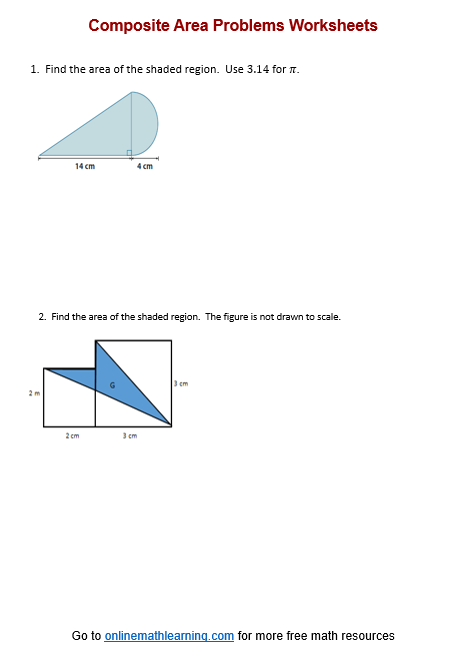
More Composite Area Worksheets
Printable (Answers on the second page.) Composite Area Worksheet #1 Composite Area Worksheet #2 Composite Area Worksheet #3 Composite Area Worksheet #4
Related Lessons & Worksheets
Composite Area Problems
More Printable Worksheets

We welcome your feedback, comments and questions about this site or page. Please submit your feedback or enquiries via our Feedback page.

Surface Area of Composite Figures
A composite solid is a solid that is composed, or made up of, two or more solids. The solids that it is made up of are generally prisms, pyramids, cones, and cylinders. In order to find the surface area of a composite solid, you need to know how to find the surface area of prisms, pyramids, cones, and cylinders.
To find the surface area of a composite 3D figure, add the areas of each geometric figure making up the composite 3D figure.
1. Separate the composite figure into all of its faces. Remember that there is no face where two figures join. 2. Find the area of each individual face. 3. Add all of the areas together. 4. Write the total surface area with the appropriate square units.
The top pyramid has two surfaces that are triangles with a height of 7 m and a base of 4 m. Its other two triangular surfaces have a height of 7 m and a base of 5 m.
= 63 m 2 for the top.
The bottom pyramid has two surfaces that are triangles with a height of 9 m and a base of 4 m. Its other two triangular surfaces have a height of 9 m and a base of 5 m.
= 81 m 2 for the top.
The total surface area is 63 m 2 + 81 m 2 = 144 m 2 .
Practice Surface Area of Composite Figures
Practice Problem 1

Practice Problem 2

Practice Problem 3

Surface area: It is the sum of the areas of all the surfaces of a three-dimensional figure.
Lateral area: It is the surface area of the figure, excluding the area of the base(s) of a three-dimensional figure.
Composite solid – a shape composed of a combination of other 3d solids.
Pre-requisite Skills Nets of 3 Dimensional Figures Surface Area of Prisms Surface Area of Pyramids Surface Area of Cylinders Surface Area of Cones Measurement – Perimeter Measurement – Area Circumference and Area of Circles Surface Area of Rectangular Prisms
Related Skills Volume of Pyramids Volume of Prisms Volume of Spheres Volume of Cylinders Volume of Cones Volume of Rectangular Prisms Volume of Composite Figures
Search Functionality Update!
To optimize your search experience, please refresh the page.
Windows: Press Ctrl + F5
Mac: Use Command + Shift+ R or Command + Option + R
Mobile: Tap and hold the refresh icon, then select "Hard Refresh" or "Reload Without Cache" for an instant upgrade!
- Child Login
- Number Sense
- Measurement
- Pre Algebra
- Figurative Language
- Reading Comprehension
- Reading and Writing
- Science Worksheets
- Social Studies Worksheets
- Math Worksheets
- ELA Worksheets
- Online Worksheets
Browse By Grade
- Become a Member

- Kindergarten

- Skip Counting
- Place Value
- Number Lines
- Subtraction
- Multiplication
- Word Problems
- Comparing Numbers
- Ordering Numbers
- Odd and Even Numbers
- Prime and Composite Numbers
- Roman Numerals
- Ordinal Numbers

- Big vs Small
- Long vs Short
- Tall vs Short
- Heavy vs Light
- Full, Half-Full, or Empty
- Metric Unit Conversion
- Customary Unit Conversion
- Temperature

- Tally Marks
- Mean, Median, Mode, Range
- Mean Absolute Deviation
- Stem and Leaf Plot
- Box and Whisker Plot
- Permutations
- Combinations

- Lines, Rays, and Line Segments
- Points, Lines, and Planes
- Transformation
- Ordered Pairs
- Midpoint Formula
- Distance Formula
- Parallel and Perpendicular Lines
- Surface Area
- Pythagorean Theorem

- Significant Figures
- Proportions
- Direct and Inverse Variation
- Order of Operations
- Scientific Notation
- Absolute Value

- Translating Algebraic Phrases
- Simplifying Algebraic Expressions
- Evaluating Algebraic Expressions
- Systems of Equations
- Slope of a Line
- Equation of a Line
- Quadratic Equations
- Polynomials
- Inequalities
- Determinants
- Arithmetic Sequence
- Arithmetic Series
- Geometric Sequence
- Complex Numbers
- Trigonometry
Area of Composite Shapes | Compound Figures Worksheets
- Geometry >
- Composite Figures
Access our exclusive collection of area of composite shapes worksheets and take advantage of the lifehacks it provides to enhance the productivity and efficiency while finding the area of compound figures. Just as breaking a difficult task into simple activities is how it is best accomplished, partitioning complex shapes into simple geometric figures is how the job gets done here! Jumpstart your learning with our free worksheets!
Adding Regions
Instruct 7th-grade kids to decompose the composite figures (or compound shapes) into simple ones, find the areas of the simple shapes, and then add them together to determine the area of the shaded region.
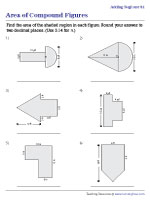
Subtracting Regions
In these area of compound shapes pdfs , learners in grade 7 and grade 8 mentally work out the basic shapes involved, calculate the area of those geometric shapes individually, and subtract them to find the answer.
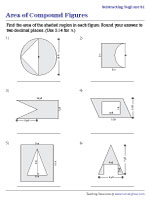
Adding and Subtracting Regions
See how effectively students in 8th grade and high school break down each composite shape, find the area of the individual geometric figures, and solve the illustrated problems in these area of composite shapes worksheets.
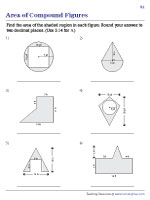
Finding Area of Rectangular Paths | Level 1
Split the shape into smaller rectangles, calculate the areas of the smaller rectangle, and add/subtract to find the area of the highlighted portion.
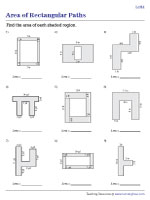
Finding Area of Rectangular Paths | Level 2
This bundle of printable worksheets has excellent practice in store for learners to find the area of rectangular paths.
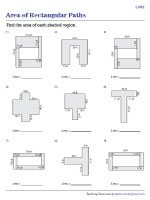
Area of Rectilinear Figures
Watch how brilliantly students tackle this collection of printable worksheets! Young learners have to decompose the given figure into simple shapes to find the area of the rectilinear figure.
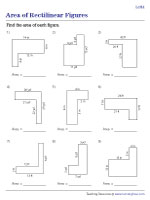
Related Printable Worksheets
▶ Area of Mixed 2-Dimensional Shapes
▶ Area of a Polygon
Tutoringhour
What we offer, information.
- Membership Benefits
- How to Use Online Worksheets
- How to Use Printable Worksheets
- Printing Help
- Testimonial
- Privacy Policy
- Refund Policy
Copyright © 2024 - Tutoringhour
You must be a member to unlock this feature!
Sign up now for only $29.95/year — that's just 8 cents a day!
Printable Worksheets
- 20,000+ Worksheets Across All Subjects
- Access to Answer Key
- Add Worksheets to "My Collections"
- Create Custom Workbooks
Digitally Fillable Worksheets
- 1100+ Math and ELA Worksheets
- Preview and Assign Worksheets
- Create Groups and Add Children
- Track Progress
- Inspiration
If you're seeing this message, it means we're having trouble loading external resources on our website.
If you're behind a web filter, please make sure that the domains *.kastatic.org and *.kasandbox.org are unblocked.
To log in and use all the features of Khan Academy, please enable JavaScript in your browser.
Grade 7 (TX TEKS)
Course: grade 7 (tx teks) > unit 8.
- Area of a shaded region
- Shaded areas
- Area of composite figure with circles
- Area of composite figure with parallelograms
Find area of composite figures
- Your answer should be
- an integer, like 6
- a simplified proper fraction, like 3 / 5
- a simplified improper fraction, like 7 / 4
- a mixed number, like 1 3 / 4
- an exact decimal, like 0.75
- a multiple of pi, like 12 pi or 2 / 3 pi
Area of Composite Figures Worksheets 7th Grade
Area of composite figures worksheets 7th grade is used to clarify concepts related to composite figures. The problems included in the worksheets are based on breaking down composite figures into simpler problems and then using the respective area formulas to solve the complete problem.
Benefits of Area of Composite Figures Worksheet 7th Grade Answer Key
Solving problems on composite figures can tend to get confusing if a student lacks visualization skills. To develop these skills, the best way is to solve several problems available in the area of composite figures worksheets 7th grade. This enables students to build a strong foundation for the topic. In addition to this, these grade 7 math worksheets help students to develop their analytical and logical thinking skills.
Printable PDFs for Grade 7 Area of Composite Figures Worksheets
The area of composite figures worksheets for 7th grade is easy to use, free to download, and available in PDF format.
- Math 7th Grade Area of Composite Figures Worksheet
- 7th Grade Area of Composite Figures Math Worksheet
- Seventh Grade Area of Composite Figures Worksheet
- Grade 7 Math Area of Composite Figures Worksheet
Explore more topics at Cuemath's Math Worksheets .

- Competition Program
How to Calculate the Area of Composite Figures
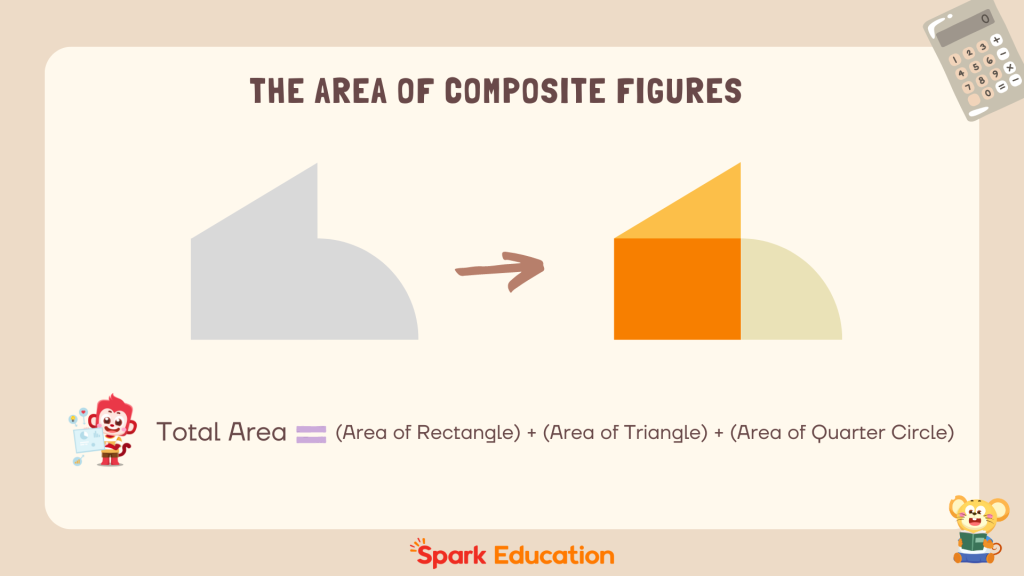
Computing the area of a composite figure requires breaking it down into its simpler components. Here’s a step-by-step process:
Step 1: Identify the Simple Shapes
Examine the composite figure and determine the individual shapes it comprises. For example, the composite shape given in the first picture includes a square, a right triangle and a quarter circle.
Step 2: Calculate the Area of Each Simple Shape
Using standard formulas for area calculation, find the area of each simple shape:
- Rectangle: Area = length × width
- Triangle: Area = 1/2 × base × height
- Quarter Circle: Area = 1/4 × π × (radius)^2
Step 3: Sum Up the Areas
Add the areas of all the simple shapes to get the total area of the composite figure.
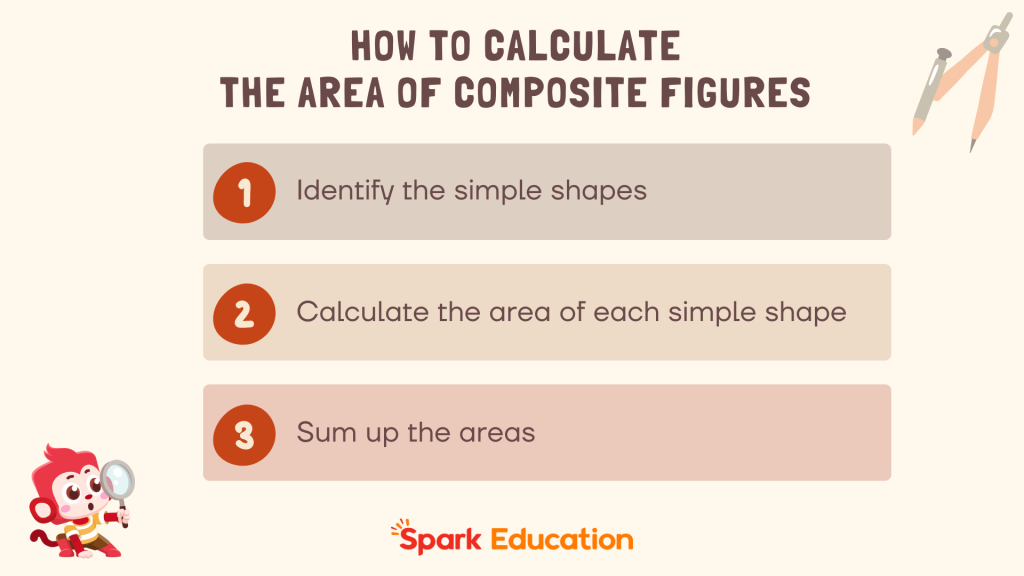
Here is a list of the area formulas for basic shapes:
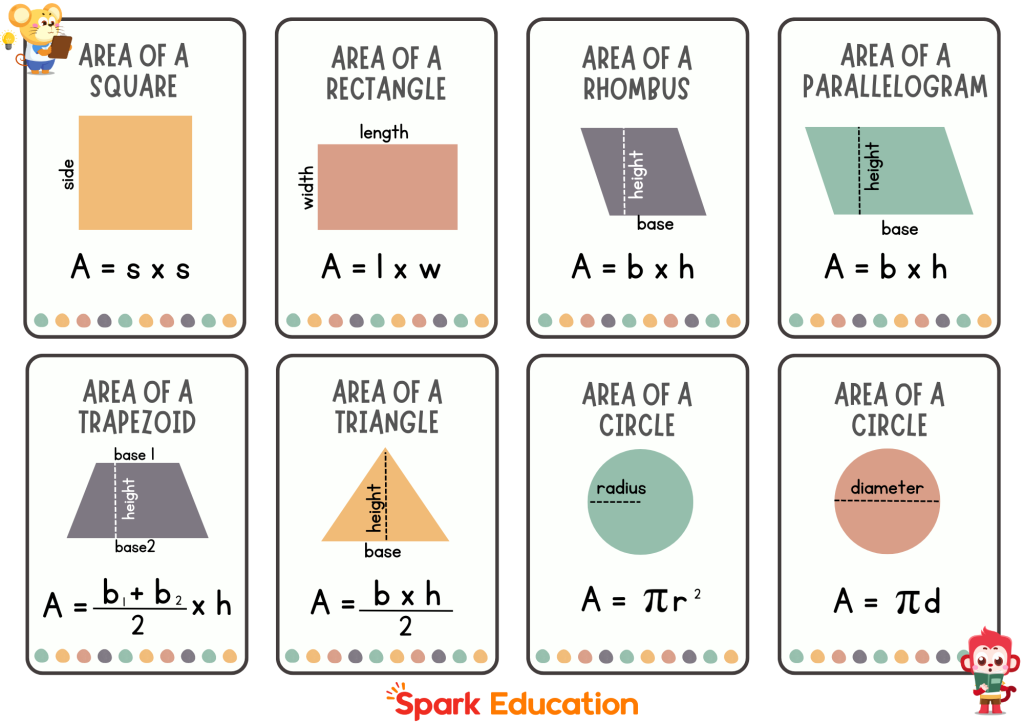
Practice Problems and Solutions
Problem 1: Find the area of the composite shape below
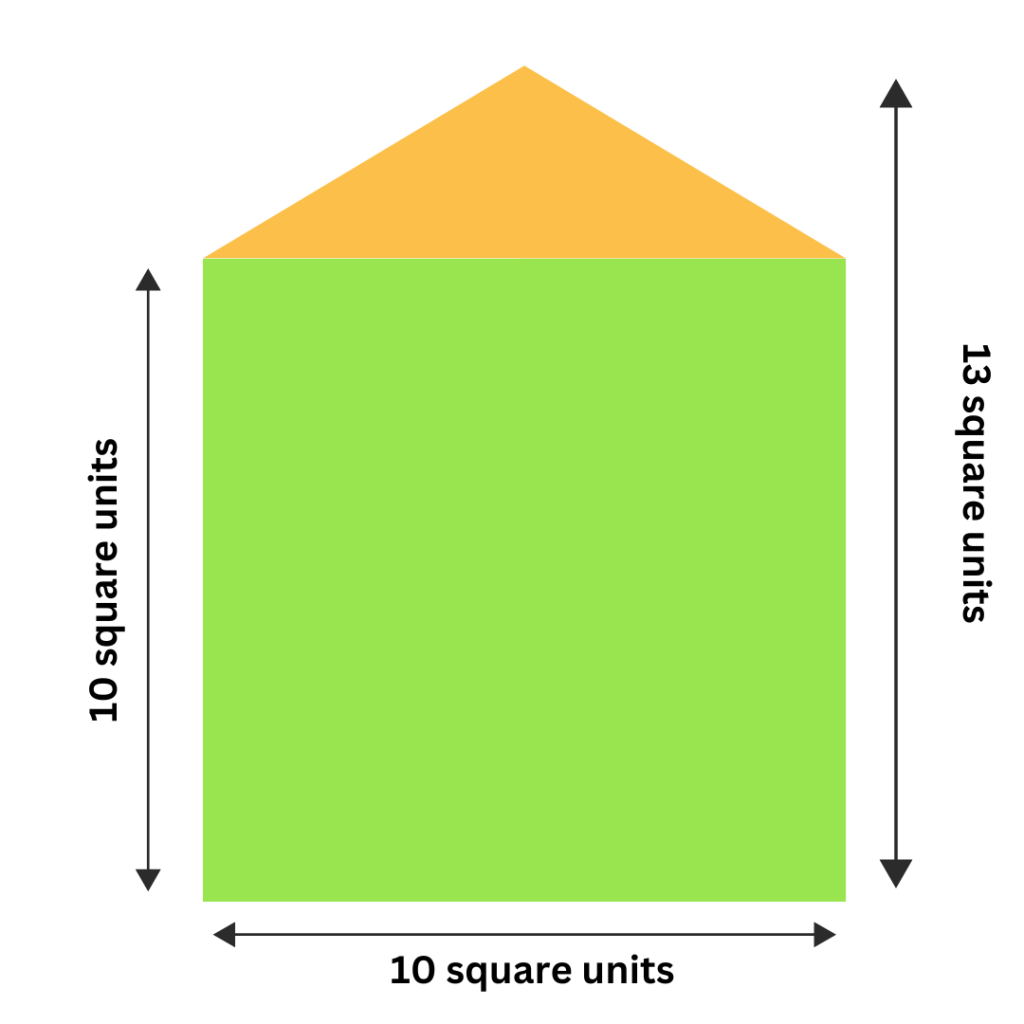
- Area of the square: 10^2 = 100 square units.
- Area of the triangle: 1/2 × 10 × (13 – 10) = 1/2 × 10 × 3 = 15 square units.
- Total Area: 100 + 15 = 115 square units.
Problem 2: A composite shape consists of a square and a right triangle with a total area of 200 square units. If the square’s area is 100 square units, find the triangle’s area.
- Area of the triangle: 200 − 100 = 100 square units.
How do you determine the area of composite figures?
To calculate the area of composite or irregularly shaped figures, start by breaking them down into simpler, non-overlapping shapes. Calculate the area of each of these simpler shapes individually using standard area formulas. Finally, sum up these areas to get the total area of the composite figure.
What are the steps to compute the area of composite shapes?
- Break down the composite shape into basic geometric shapes.
- Calculate the area of each basic shape separately.
- Sum the areas of all the basic shapes to obtain the total area of the composite shape.
What does it mean to decompose a composite figure?
Decomposing a composite figure involves breaking it down into two or more simpler, non-overlapping shapes. This process simplifies the calculation of the figure’s area or for analyzing its components.
Understanding how to calculate the area of composite figures is a valuable skill in both academic and real-world contexts. By breaking down complex figures into simpler shapes and summing their individual areas, we can accurately determine the total area. Keep practicing with different composite shapes to enhance your skills.
Interested in taking your child’s math skills to the next level? Enroll in our FREE Spark Math trial class today! Spark Math is the flagship math course under Spark Education, offering small group classes taught by experienced and engaging real-life teachers. Our program is designed to ignite your child’s passion for learning math, providing a rich array of math resources and an immersive learning experience. Come and see how Spark Math can make a difference in your child’s education!
Spark Passion for Learning, Ignite Lifelong Growth

- About Spark Education
- Spark Education Group
- Spark Math Program
Copyright © 2023 Spark Education

Sign in to your account
Username or Email Address
Remember Me
| | > >
|
Chapter 7, Lesson 3: Area of Composite Figures
- Extra Examples
- Personal Tutor
- Self-Check Quizzes
The resource you requested requires you to enter a username and password below:
| Password: | |
Please read our Terms of Use and Privacy Notice before you explore our Web site. To report a technical problem with this Web site, please contact the site producer .


IMAGES
VIDEO
COMMENTS
Learn for free about math, art, computer programming, economics, physics, chemistry, biology, medicine, finance, history, and more. Khan Academy is a nonprofit with the mission of providing a free, world-class education for anyone, anywhere.
Free area of composite shapes math school topic guide, including step-by-step examples, free practice questions, teaching tips, and more! ... applying this technique to solve real world problems. Grade 4 - Measurement and Data (4.MD.3) ... offer students a variety of ways to practice finding the area of composite shapes. One idea is for ...
Click here for Answers. shape, L-shape. Practice Questions. Previous: Tessellations Practice Questions. Next: Area of a Hexagon Practice Questions. The Corbettmaths Practice Questions and Answers on Area of Compound Shapes.
Rules. 1. Read the word problem and decompose the composite figure into simpler shapes of which you can find the area. 2. Write down the area formulas of the simpler shapes. 3. Substitute the given values into the formulas. 4. Add or subtract the areas of the simple shapes as needed and state the correct square units.
This compilation of meticulously crafted printable area of compound shapes worksheets for students of 6th grade, 7th grade, and 8th grade extends two levels of composite figures to prep up finding the area. Simple plane shapes like triangles, rectangles, squares, parallelograms, rhombus, trapezoids, circles, semicircles, and quadrants compose ...
%PDF-1.6 %âãÏÓ 80 0 obj >stream hÞ¤'ßjƒ0 Æ_å¼ÀšÄüS(^Ô¥Œ±R½ ˆ gÃèXk‰ º·ßIL eƒ^ì"ɧß9ŸÇŸ2 ÀA$À î æsRôãÑAB ÷»¡æèo½‰GCª¯"!›öÝ y * Î Ý*ñ>)l ZôçšÎ(ø%3 »NùŒ6äÉìömp!8þ~ƒa €…þ úÑvf ÙŸ½-OmgüE‰1™¯Ésòpv«ÒµÎ +oèм* FÆš%Næû'W Š ¿ªð±:J 2 2Áab×Æö]i\M6÷KR™³#ë ¾ì¢!/Ïo ¦ó'ë ...
Area of Composite Shapes Worksheets. In an area of composite shapes, we will learn how a composite shape is a shape made up of other shapes.To find the area of such a shape, simply find the area of each part and add them up. Area Addition Postulate: If a figure is composed of two or more parts that do not overlap each other, then the area of the figure is the sum of the areas of the parts.
Here are the steps to solve composite area problems: Identify the Simple Shapes: Break down the composite shape into recognizable simple shapes such as rectangles, triangles, circles, semi-circles, etc. Calculate Individual Areas: Use the appropriate formulas to find the area of each simple shape. Combine the Areas: Sum the areas of the simple ...
Area of Composite Figures Practice and Problem Solving: A/B Estimate the area of each figure. Each square represents 1 square foot. ... Area of Composite Figures Reteach When an irregular figure is on graph paper, you can estimate ... You can break a composite figure into shapes that you know. Then use those shapes to find the area. A ...
you use to solve this problem? Math Practice. 8.4 Lesson 340 Chapter 8 Circles and Area EXAMPLE 1 Finding an Area Using Grid Paper ... Section 8.4 Areas of Composite Figures 343 Write the phrase as an expression. (Skills Review Handbook) 18. 12 less than a number x 19. a number y divided by 6
To find the surface area of a composite 3D figure, add the areas of each geometric figure making up the composite 3D figure. Rules. 1. Separate the composite figure into all of its faces. Remember that there is no face where two figures join. ... Practice Problem 3. Jessica needs to paint all sides of the dollhouse shown below.
Section 9.3 Perimeters and Areas of Composite Figures 379 Go to BigIdeasMath.com to get HELP with solving the exercises. 9.3 Practice Review & Refresh Find the area of the circle. Use 3.14 or 22 — 7 for 𝛑. 1. 4 mm 2. 9 ft Find the missing dimension. Use the scale 1 : 5. Item Model Actual 3. House Height: 6 ft Height: ft 4.
Watch how brilliantly students tackle this collection of printable worksheets! Young learners have to decompose the given figure into simple shapes to find the area of the rectilinear figure. Plug into our free printable area of composite shapes worksheets to acquire the skill of computing the area of compound figures using appropriate formulas.
Improve your math knowledge with free questions in "Area of composite figures" and thousands of other math skills.
Problem. and 2 rectangles. What is the area of the shape? Learn for free about math, art, computer programming, economics, physics, chemistry, biology, medicine, finance, history, and more. Khan Academy is a nonprofit with the mission of providing a free, world-class education for anyone, anywhere.
The problems included in the worksheets are based on breaking down composite figures into simpler problems and then using the respective area formulas to solve the complete problem. Benefits of Area of Composite Figures Worksheet 7th Grade Answer Key. Solving problems on composite figures can tend to get confusing if a student lacks ...
Your Answer. 2. perimeter =. area =. Solution. To get the perimeter, add up the lengths of all the sides. Perimeter = 1 cm + 1 cm + 3 cm + 4 cm + 4 cm + 3 cm = 16 cm. Looking at this figure, you can see that the figure is made up of rectangles. To get the figure's area, add up the areas of the smaller rectangles.
Show the divisions on the floor plan with dotted lines. Count the units to find the dimensions. Label the dimensions. Then find the area of each of your shapes. The area of the composite figure is. yd2. B) To calculate the cost to carpet the room, multiply. The cost to carpet the banquet room is . C) Describe how you can estimate the cost to ...
Here is a list of the area formulas for basic shapes: Practice Problems and Solutions. Problem 1: Find the area of the composite shape below. Solution: Area of the square: 10^2 = 100 square units. Area of the triangle: 1/2 × 10 × (13 - 10) = 1/2 × 10 × 3 = 15 square units. Total Area: 100 + 15 = 115 square units. Problem 2: A composite ...
Area of Composite Figures. Practice and Problem Solving: A/B. Estimate the area of each figure. Each square represents 1 square foot. 1. 2. Find the area of each figure. Use 3.14 for . 3.
This video will teach you how to get the area of composite figures.#areaoffigures #compositefigures #areaofcompositefiguresCREDITS and thanks are given to th...
Reading in the Content Area Real-World Careers Standardized Test Practice Vocabulary Review ... Home > Chapter 7 > Lesson 3. New York Math Connects: Concepts, Skills, and Problem Solving, Course 3. Chapter 7, Lesson 3: Area of Composite Figures. Extra Examples; Personal Tutor; Self-Check Quizzes; Log In. The resource you requested requires you ...
Reading in the Content Area ... Standardized Test Practice Vocabulary Review Lesson Resources Extra Examples Group Activity Cards Personal Tutor ... Study to Go. Mathematics. Home > Chapter 7 > Lesson 3. Math Connects: Concepts, Skills, and Problem Solving, Course 3. Chapter 7, Lesson 3: Area of Composite Figures. Extra Examples; Personal Tutor ...